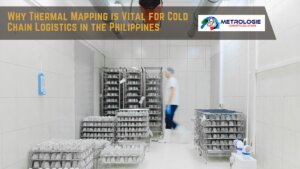In the healthcare sector, maintaining the integrity of sensitive medical products, pharmaceuticals, and even environmental conditions is critical. Healthcare facilities in the Philippines, ranging from hospitals to laboratories and pharmacies, rely heavily on the accuracy of temperature control and monitoring. In a tropical country where temperature and humidity can fluctuate significantly, the stakes are high. Poor temperature management can lead to compromised medicines, inaccurate test results, and even life-threatening situations.
One of the most effective ways to ensure that temperature-sensitive environments are consistently monitored and controlled is through thermal mapping. Thermal mapping is a process used to identify and document temperature variations within a controlled environment. It is essential for validating storage areas, ensuring compliance with regulatory standards, and protecting the quality and safety of medical products.
This comprehensive guide will explore the importance of thermal mapping for healthcare facilities in the Philippines, the specific challenges faced in this region, and best practices for implementing an effective thermal mapping program.
1. Understanding Thermal Mapping
What is Thermal Mapping?
Thermal mapping is the process of recording and analyzing temperature data across different areas within a specific environment. This could include storage rooms, warehouses, refrigerators, and transportation vehicles. The goal of thermal mapping is to identify hot and cold spots, temperature variations, and the effectiveness of cooling or heating systems. By understanding these variations, healthcare facilities can ensure that their environments remain within safe temperature ranges.
Key Components of a Thermal Mapping Process
- Data Loggers: These are devices used to monitor and record temperature data over time. They are strategically placed in different areas to capture a comprehensive thermal profile.
- Mapping Plan: A detailed plan that outlines the placement of data loggers, the duration of the mapping process, and the specific conditions being monitored.
- Analysis: After data collection, the results are analyzed to identify trends, deviations, and areas that require adjustments.
- Validation: Once the thermal mapping is complete, the results are validated to ensure they meet regulatory standards and internal quality requirements.
Applications in Healthcare
In healthcare, thermal mapping is particularly critical in areas such as:
- Pharmaceutical Storage: Ensuring that drugs and vaccines are stored at the correct temperature to maintain their efficacy.
- Laboratories: Maintaining the right conditions for sensitive equipment and samples.
- Hospital Pharmacies: Protecting the integrity of medications dispensed to patients.
- Blood Banks: Ensuring that blood products are stored within the required temperature range.
2. The Importance of Thermal Mapping in the Philippine Healthcare Sector
Climate Challenges in the Philippines
The Philippines experiences a tropical climate characterized by high humidity and significant temperature fluctuations between the dry and wet seasons. These environmental conditions pose a challenge for maintaining stable temperatures in healthcare facilities. Without proper thermal mapping, it is difficult to ensure that temperature-sensitive areas remain within safe ranges, leading to potential risks for patient safety and product quality.
Compliance with Regulatory Standards
Healthcare facilities in the Philippines are subject to stringent regulations from both local and international authorities. The Food and Drug Administration (FDA) of the Philippines, for example, mandates strict guidelines for the storage of pharmaceuticals and medical products. Thermal mapping is essential for demonstrating compliance with these regulations, which helps avoid penalties, ensures product safety, and maintains the facility’s reputation.
Protecting Patient Safety
Temperature-sensitive products, such as vaccines, blood products, and certain medications, must be stored within specific temperature ranges to remain effective. Deviations from these ranges can compromise the integrity of these products, potentially leading to ineffective treatments or adverse reactions in patients. Thermal mapping helps prevent these risks by ensuring that storage conditions are consistently monitored and controlled.
Reducing Financial Losses
Healthcare facilities can face significant financial losses if temperature-sensitive products are compromised. Spoiled pharmaceuticals, for example, may need to be discarded, resulting in costly waste. Additionally, non-compliance with regulatory standards can lead to fines and legal actions. Thermal mapping helps mitigate these risks by ensuring that storage conditions are optimized, reducing the likelihood of product spoilage and regulatory issues.
3. Key Areas in Healthcare Facilities That Require Thermal Mapping
Pharmaceutical Storage Rooms
Pharmaceuticals are highly sensitive to temperature fluctuations. Even minor deviations can render them ineffective or unsafe. Thermal mapping ensures that storage rooms maintain the required temperature range, protecting the integrity of these products.
Cold Storage Units
Cold storage units, including refrigerators and freezers, are used to store vaccines, blood products, and other temperature-sensitive items. Thermal mapping helps identify areas within these units that may experience temperature variations, allowing for adjustments to ensure consistent cooling.
Laboratories
In laboratories, temperature control is essential for accurate test results and the preservation of samples. Thermal mapping helps maintain the required environmental conditions for sensitive equipment and materials, ensuring that laboratory results are reliable.
Hospital Pharmacies
Hospital pharmacies dispense a wide range of medications, many of which require strict temperature control. Thermal mapping ensures that these medications are stored properly, reducing the risk of dispensing compromised products to patients.
Transportation Vehicles
The transportation of temperature-sensitive products between facilities requires careful monitoring. Thermal mapping can be applied to vehicles to ensure that products remain within the required temperature range throughout transit, reducing the risk of spoilage.
4. Best Practices for Implementing Thermal Mapping in Healthcare Facilities
Developing a Thermal Mapping Plan
Before implementing thermal mapping, it is essential to develop a comprehensive plan that outlines the process. This plan should include:
- Objective: Define the goals of the thermal mapping process, such as validating a new storage area or ensuring compliance with regulations.
- Placement of Data Loggers: Determine the strategic placement of data loggers to capture a complete thermal profile of the area.
- Duration: Decide the duration of the thermal mapping process, typically ranging from 24 hours to several days, depending on the environment.
- Environmental Conditions: Consider factors such as the time of year, weather conditions, and occupancy levels that may affect temperature readings.
Using the Right Equipment
The accuracy of thermal mapping depends on the quality of the equipment used. Choose data loggers that are calibrated and capable of recording data at the required intervals. It is also important to select loggers that are suitable for the specific environment, whether it is a cold storage unit, a large warehouse, or a small laboratory.
Regular Monitoring and Analysis
Thermal mapping is not a one-time process. Regular monitoring is necessary to ensure that conditions remain consistent over time. Analyze the data collected during thermal mapping to identify trends, areas of concern, and opportunities for improvement. This ongoing process helps maintain optimal conditions and prevents potential issues before they arise.
Validation and Documentation
After completing thermal mapping, validate the results to ensure they meet regulatory standards and internal quality requirements. Proper documentation is crucial for compliance and should include detailed reports of the mapping process, data collected, analysis, and any corrective actions taken.
Continuous Improvement
Thermal mapping is an ongoing process that requires continuous improvement. Regularly review and update your thermal mapping plan to account for changes in the environment, equipment, or regulatory requirements. By staying proactive, healthcare facilities can maintain high standards of safety and compliance.
5. The Role of Technology in Enhancing Thermal Mapping
Advanced Data Loggers
Modern data loggers offer advanced features such as wireless connectivity, real-time monitoring, and automated alerts. These capabilities enhance the accuracy and efficiency of thermal mapping, allowing healthcare facilities to respond quickly to temperature deviations.
Software Solutions
Specialized software can be used to analyze thermal mapping data, generate reports, and track trends over time. These tools streamline the process and provide valuable insights that can be used to optimize temperature control systems.
Integration with IoT
The Internet of Things (IoT) is revolutionizing thermal mapping by enabling the integration of data loggers with centralized monitoring systems. IoT devices can provide real-time data, remote access, and automated alerts, making it easier to maintain optimal conditions and ensure compliance.
6. Case Studies: Successful Thermal Mapping in Philippine Healthcare Facilities
Case Study 1: Pharmaceutical Company
A leading pharmaceutical company in the Philippines implemented thermal mapping in its storage facilities to comply with FDA regulations. The process identified several hot spots that could have compromised the integrity of stored products. By addressing these issues, the company was able to maintain consistent temperatures, ensuring the safety and efficacy of its products.
Case Study 2: Hospital Blood Bank
A major hospital in Manila conducted thermal mapping in its blood bank to ensure that blood products were stored within the required temperature range. The results revealed temperature fluctuations due to inadequate insulation in one of the storage units. By upgrading the insulation and optimizing the placement of data loggers, the hospital improved its temperature control, reducing the risk of compromised blood products.
Case Study 3: Laboratory Facility
A laboratory facility in Cebu used thermal mapping to validate its new cold storage room for sensitive samples. The mapping process highlighted an area with insufficient cooling, which was quickly addressed by adjusting the airflow. The laboratory achieved consistent temperatures across the storage room, ensuring the accuracy and reliability of its test results.
Conclusion: Ensuring Safety and Compliance Through Thermal Mapping
Thermal mapping is a critical component of temperature control and monitoring in healthcare facilities across the Philippines. By understanding and implementing effective thermal mapping practices, healthcare providers can protect the integrity of temperature-sensitive products, comply with regulatory standards, and ensure the safety and well-being of patients.
For healthcare facilities in the Philippines, where climate conditions pose unique challenges, thermal mapping is not just a regulatory requirement—it’s a vital part of maintaining quality and safety. Investing in the right equipment, developing a comprehensive plan, and continuously monitoring and improving temperature control systems will help ensure that healthcare facilities provide the best possible care for their patients.


